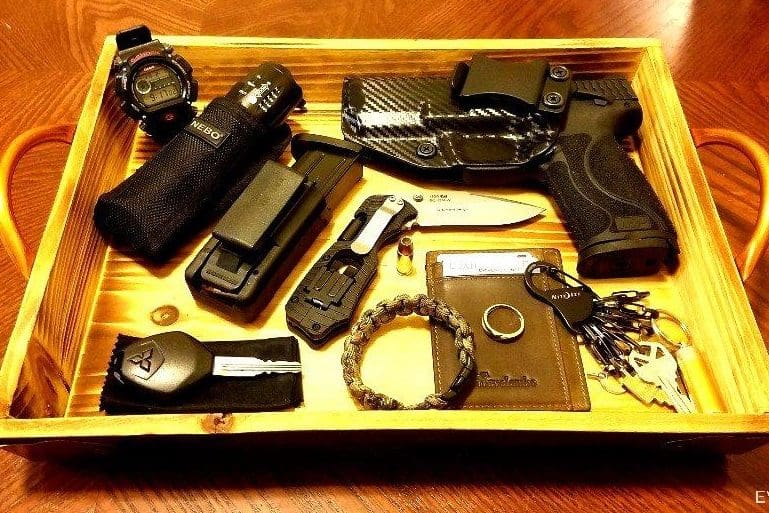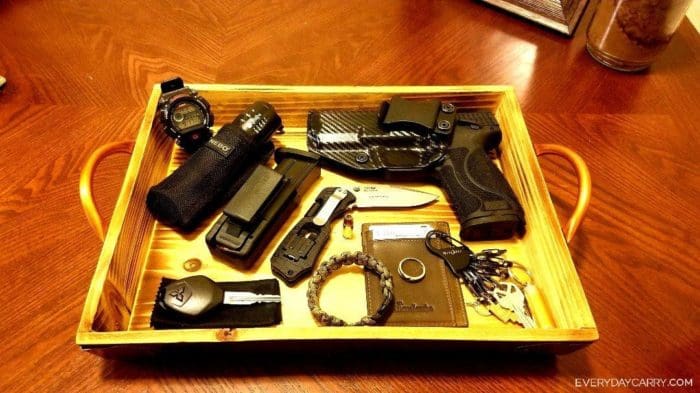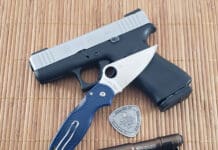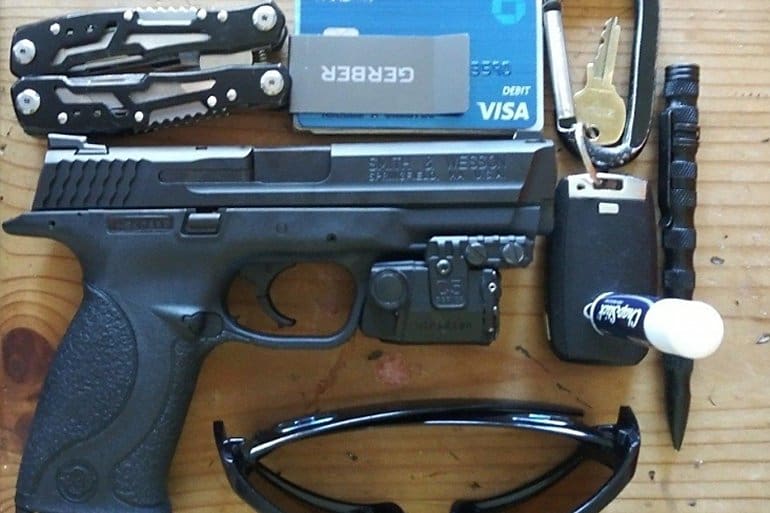Robert says he recently updated his EDC: “Just bought the Kershaw Select Fire. And upgraded to the BLACKHAWK! mag holster. And just bought the Drop Box for my edc.”
His daily carry is a Smith & Wesson M&P 2.0 chambered in 9mm. I noticed he has the model with an external thumb safety. What do you guys think of external versus internal safety mechanisms? Do you prefer having a thumb safety or no external safety?
And if you do have a thumb safety do you use it on your holstered gun and have you trained to speed the time it takes you to draw and flip the safety off before firing?







It is important that if any of your carry guns have a thumb safety, they all should. If you mix, you are asking for trouble when stress is high and you need to deploy in a hurry. If you do carry with a thumb safety, practice, practice, practice. It should be second nature to flip the safety off as you draw. If you have any doubts about being able to remember the safety when you are in a crisis situation, don’t have one.
I agree with the all or nothing approach, which is why I just changed my carry from a Glock 23 to a Springfield EMP9 4”. My wife had a P938, which I found myself carrying occasionally. Now we each have a gun with the same exact features, just different sizes.
Besides, I simply shoot this one better than the Glock. And the safety is so easy to actuate, I don’t see it as a hindrance.
The 938 is a 1911 patterned pistol but it is not a real 1911. You can safely carry a 1911 with the thumb safety disengaged because it has a grip safety. It isn’t safe to carry a 938 with a chambered round with the safety disengaged
Can doesn’t mean should. And plenty of things will bump a grip safety.
Both should be carried cocked and locked. But more so, both operate the same. The grip safety is just as invisible to the shooter as the trigger of a Glock, which is why I didn’t mention it. It doesn’t change the thought or action process of drawing and firing, but provides an extra layer against negligence.
But I don’t know anyone that advises carrying a 1911 without the safety engages. And I don’t carry the 938 without the safety engaged. Which is why I decided to switch. Pick up the gun, disengage safety, fire. Both require the same process.
If you carry any gun In a holster and keep your hands off of it it isn’t going to go off. Most GIs disengaged the safety on their holstered pistols in the presence of the enemy. The original Browning design was grip safety only so he thought it was sufficient. The thumb safety was added at the request of Cavalry Board.
Sam Wrights comment is right on, he sums it all up.
Personally I don’t buy guns anymore with with safeties except for 1911’s and my FN FNX. I used to pin the grip safeties on 1911’s but realized that my particular hand depresses a grip safety every time. I don’t remember the FNX coming with a no external safety option and their safety lever is also the decocker. Oh, forgot about my two Browning Hi-Powers… they have very small safety levers for a gun that can be carried cocked and locked.
I agree with external safety on EDC. Same as using shotgun to shoot skeet and trap from carry position or when carrying my shotgun when bird hunting with safety on. Never know when safety comes off; never know when safety goes back on……muscle memory after much practice…..never missed a shooting opportunity because safety did not come off. Also, external safety is a hedge against a gun take-away attempt. Typically that person would not immediately know how to take safety off giving me a couple extra seconds to respond before perp could shoot.
Carried a 1911 cocked and locked for decades. Still do. Safety on and off? Never think about it. Like putting on my socks. Just something I do. Other weapons. The same thing. Build the muscle memory. No more thought in it than applying the brakes when someone pulls out in front of me in traffic.
Just to clarify. I have carried other weapons into high stress situations besides a 1911. Because I had trained with these pistols I was never confused about what was in my hand. I really believe that if you put yourself into other nongunfight, high stress situations it will help you keep your senses in a life threatening situations. Jump out of an airplane, rappel down a cliff/wall, scuba dive (okay, not so high stress, but you have do pay attention to detail.) Shoot a match. God forbid, take some real training. Anything to get the adrenaline flowing. It works!
OH COME ON MAN!! All the ex-spurts on here spew all the time, you don’t need to practice and train! All you gotta do point in the general direction and pull the trigger! It’s thats simple!🤦♂️
The gum comes out of the Holstein. At two o’clock the safety is disengaged. At three o’clock sights aligned, *BLAM* *BLAM* ,,,sht missed again
You carry a cow on your hip? Where do you holster your weapon? In it’s ass? Bet that’s a bitch to conceal.
could be a lot of bull, dehorned of course.
and cud flavored gum.
udder nonsense.
I mix by season. When I lived in Virginia I hardly ever wore gloves so I carried a 1911 or BHP all year round. Since moving to the Great White North I discovered how hard it was to manipulate a safety with heavy gloves so once high temperatures drop below freezing on a regular basis I switch to a striker fired pistol. Normally that happens from early December through early March. This year I started carrying my APX in November and I wouldn’t be surprised if I don’t switch back until April.
LC9s Pro, no safety except the most important one, the one between my ears.
LCP, Glock 43 and 48, and LCR…..no safety.
SR9 and SR9c …. safety.
No big deal to me….same draw for every pistol and would sweep the safety off.
None of my revolvers ever had a safety and never had a problem when carrying a 1911.
Much ado about nothing. Most of the people squawking about safety vs no safety seem to be those justifying their “no safety” decision.
It’s been some years ago now but scope this out…..
There was a guy on here who was used to external safety type pistols. He started carrying a Glock. Well next thing you know he has an attempted car jacking. Evidently someone hopped in the passenger seat of his truck at a store while he waited on a friend. He draws the Glock gets it on the would nor doweller’s temple….try as he may he cannot seem to get the weapon to fire. After what he says seems like a century the attacker gets out and runs away. Dude of course wonders why his Glock failed to shoot….Turns out he has failed to depress the center of the trigger shoe. As you know that’s your safety on a Glock. He got lambasted on here by all the self defense experts. I thought it was a cool story, you have to love the irony.
I’m not a big fan of external safeties in general and where my guns have them I use them only for administrative handling purposes.
That said, I did train myself to swipe the safety off on my USP specifically because it can get knocked to “safe” while carrying the gun IWB and obviously if you’re drawing it you may very well need it to go *bang* right away.
Other than that, IMHO, external safeties are for long guns. Pistols, because they’re carried in a holster that covers the trigger guard don’t need them. JMB and I agree on this and from my point of view that means I’m in pretty good company.
Bell and Howell Taclite. Lol.
I “grew up” on a steady diet of revolvers (no active safety) and still carry a hammer less snub nose 38 about half the time. When the plastic (sorry, polymer) compact and sub compact nines became common, I chose a Kahr P9 and later a PM9 as alternate EDC’s. I had two reasons for my choice: 1) the Kahr fits my smallish hand perfectly, and 2) it’s a “square revolver”; same drill (draw gun, point gun, pull trigger); same longer, heavier trigger; same safety protocol (finger OFF the trigger until sights on target….). With all due appreciation for 1911 fans, I’m too old, and not inclined, to learn new tricks.
External safety Y/N? Depends. LEARN your firearm= no issues. Have both train with both. Jumping from airplanes; check. Rappel from choppers, cliff/wall; check. Scuba dive (military and civilian); check. Shot at; check. All are stressful. Learn how to use your tools.
daveinwyo, I left off rappeling from choppers and helocasting because most citizens will never have the opportunity unless they join the military. Even then it depends on MOS/unit.
Right. Sorry. SF, fill in blanks.
You weren’t SF Dave
A few years back I bought an S&W .40 Shield for literally pocket change. Tremendous piece for the money but it came with a damn safety. I carried it while running on the rural paths with my dog for quite a while. Never engaged the safety, ever. What’s the BFD?
I have a pollock friend who worries about the G43 and Sig 365 I now carry not having a “safety”. Then when he’s occasionally packing, he’s got a J frame in some sort of idiot rig he could never clear in 30 seconds. I guess that’s his “safety”…
My main two carry weapons are an M&P .45 Compact mostly for fall and winter, and an HK P30sk in 9mm for spring and summer. Both have a thumb safety on them. I have other striker fired guns with out thumb safeties on them, like my M&P 2.0 Compact, and my PPQ. I like the idea of holstering my pistol with the safety on and then clicking it off when its in my holster. When I disarm at home I click the safety on while being stores in the various locked drawers and safes in my home.
Of course I keep one in the pipe. I believe if you are not comfortable with a round in the chamber, then you need to learn to be. Thumb safety or no thumb safety, I can’t really fault anyone either way. Just keep a round in the chamber and train to use the weapon effectively.
While I own multiple handguns I only conceal carry one of them. It has an external safety. I train with it by drawing from concealment, activating the selector to fire, and then of course firing the weapon. Thank god I have not had to use my weapon in real life. If I do, I am ready for it.
I choose to only conceal carry one of my weapons. It’s whole reason I bought this particular one. I like the familiarity I have with it. It’s easy for me to avoid printing. The manual of arms is second nature to me after 4 years. I also did nothing to modify this pistol besides putting some better grip on it.
An external safety is mandatory. I won’t even consider a pistol that lacks one.
Comments are closed.